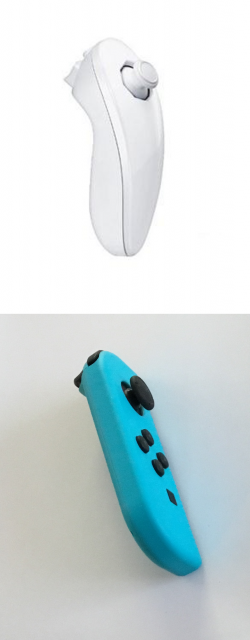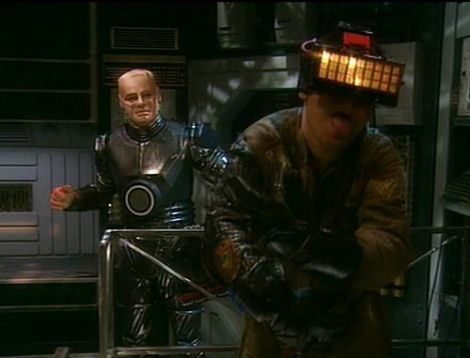Why Nintendo needs to embrace family friendly Portal VR on the Switch
Comparing my vision for a future Nintendo console to the reality of the Switch and how it could still deliver the family friendly form of virtual reality I described two years ago. Also, some notes on the merits of having an unintrusive UI in Portal VR.

I made a bunch of recommendations over two years ago about a future successor to the Wii console which would have included a paid online subscription service, less intrusive in-game tutorials as they frustrate immersion and I consider them to be inappropriate for all forms of VR.
It's alright to have a delayed prompt remind you of what contextual action can be performed in specific circumstances, as illustrated by this slo-motion clip of Far Cry 4:
Something like Horizon: Zero Dawn could be a lot tider visually if those white leaf resource markers only appeared when you were crouched and with your weapon put away. Similarly, the compass could only fade into view at the top of the screen when sprinting to a new area and would gradually fade away as you slowed down to stalk your prey. I feel that more has to be considered about reducing clutter in games, or at least the option to have it be dynamic or selectively turn parts off as your familiarity with the control scheme no longer needs this tutorial.

I also thought that it confused people to have to master a succession of controllers, and if there could just be one that would serve for simple motion control games as well as complex multiplatform titles then there wouldn't be a need for a gamepad to supplement the default motion controllers. I also decided that the functionality of a gamepad could be split across a symmetrical pair of wireless Nunchuku as the face buttons could be made concave and relocated to pits on the inside of each grip to be operated by the fingertips of the ring and middle finger of either hand.
(Y) (X) would be operated by the left hand and the right would operate (B) (A)
Rather than attempt to find room on the surface of the left Nunchuk for a misaligned D-Pad that fails to fall within the arc of motion of the thumb – as there isn't sufficient room for it to be comfortably offset – I thought that it might be possible to engineer analog sticks that could be converted into 8-way digital joysticks by screwing them deeper into their sockets. All of this refinement of the design would eliminate every inessential complexity that ordinarily intimidated a broader demographic of potential gamers. The Wii was the success that it was because people who would have been puzzled by a gamepad and been "frightened of pressing the wrong button" would look at a single Nunchuku and overlook that it had buttons hidden in the grips and triggers around the front and that the analog stick could click and twist as they just happily swung their club in Wii Golf.
The problem with the Wii was that Nintendo failed to build on the player's mastery of the Nunchuk by adding a second one for dual wielding, then progressively bring out titles that required mastery of its hidden articulacy. A pair of Nunchuku would be just as capable as a DualShock 4 because although that has a touchpad it doesn't allow either hand to be motion tracked independently, so you could argue that the motion of the left Nunchuk could be equivalent to swiping gestures performed on the surface of the DualShock 4's touchpad.
Although, I hoped that NIntendo wouldn't attempt to make a portable console to replace the 3DS XL which could be used as the controller of a home console for the continuous appreciation of a progress synchronized Monster Hunter title and was wrong in that prediction I was uncannily close with my notion of a dual Nunchuku based system with (SL) and (RL) buttons hidden on the inside edge of each grip:

The relevance of all this becomes clear when you realise how Nunchuku are well suited to controlling games whilst in VR. Their motion control is essential to your articulacy of expression in a virtual environment and they could, as in the case of the Razer Hydra be based around magnetism rather than Infra Red for precise and responsive feedback. However, I would predict that family-friendly NIntendo would not opt for full unmonitored immersion ill suited to their core market of children. A parent needs to know what their child is getting up to "in there" and a social screen could be set to show the AV input from an XBOX ONE twitch.tv stream of a PSVR game so that the parent was oblivious to what they were really immersed in.

Then there is the obvious matter of the PSVR headset not being suitable for children under the age of 12. Whether the reason for this is damage to still developing eyes, minimum head band size, or weight I don't think Nintendo would decide to bring VR to its many titles that start at a PEGI 3.
All is not lost as there is one form of VR which is better described as AR which will solve all of these problems as well as being extremely cheap and well suited to their cartoon aesthetics.
I find it rather incredible that this ten year old hack hasn't made it into a Nintendo console. Portal VR is a completely acceptable substitute for VR which could be further enhanced by Flicker-Free 1080p LED Cinema 3D TV.
The great thing about it is that the cheap Cinema 3D glasses still provide an illusion of interactive 3D space even without a 3D TV due to them incorporating Infra Red LEDs in the top corners of the frames.
Nintendo could still go forward with Portal VR on the Switch in the near future.
More detail is provided in the following 2 year old article I wrote on Gamasutra:
Read more about:
BlogsAbout the Author(s)
You May Also Like













